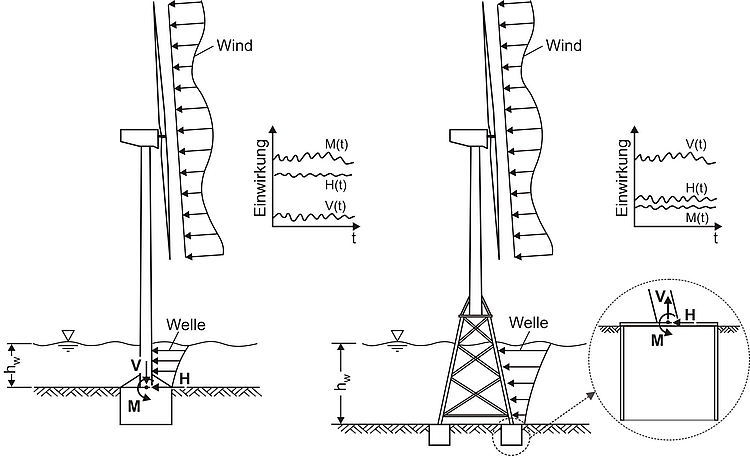Tensile Behaviour of Suction Buckets in Non-Cohesive Soils

| Led by: | Prof. Dr-Ing. Martin Achmus |
| Team: | Dipl.-Ing. Patrick Gütz |
| Year: | 2018 |
| Funding: | DFG |
| Duration: | 01.09.2015 – 31.08.2018 |
| Is Finished: | yes |
Description:
Suction bucket foundations are a promising alternative to driven tubular steel piles for the foundations of offshore wind turbines (OWT). Depending on the number of suction bucket foundations for a WTG, the construction is referred to as a monopod or multipod. While monopods are mainly loaded by horizontal forces (H) and torques (M), the vertical forces (V) are predominant for multipods (see figure). This project investigates the variant of suction bucket foundations as a multipod, whereby the case of tensile loading is decisive for this construction.
The resistance of a suction bucket to a tensile load results from its own weight, the skin friction and, if applicable, a negative pressure underneath the cover. In addition to the geometry of the suction bucket and the permeability of the soil, the development of the negative pressure is strongly dependent on the duration of the load and the speed at which the load is applied (load rate). In the case of a very low loading rate, a drained state occurs in which a constant flow into the bucket prevents negative pressure and a water-filled gap forms underneath the bucket cover. At very high load rates (undrained state), a negative pressure develops underneath the bucket lid, which prevents the development of a gap, so that the floor inside the bucket is raised (see fig. 2). It is to be expected that when a suction bucket foundation is loaded, a partially drained state will develop, whose failure mechanism and resulting heave result from the combination of the drained and undrained state.
The estimation of the resistance resulting from the negative pressure is still subject to very large uncertainties and is not taken into account in current design methods. Furthermore, there is as yet no basis for determining the accumulation of deformation due to cyclic loading, especially if this exceeds the drained load-bearing capacity. The neglect of the resulting negative pressure underestimates the economical and ecological advantages of a suction bucket foundation, just as the uncertainty regarding the deformation accumulation requires a very conservative design.
To better understand the behaviour of a suction bucket foundation under tensile load, model tests are carried out in this project. The model tests are planned with a) constant uplift velocity, b) constant load and c) cyclic loading. The results of the model tests serve as a starting point for further numerical investigations (validation and extrapolation). The model tests and numerical modelling should form the basis for deriving an analytical calculation approach that describes the various mechanisms of a suction bucket under tensile load for any boundary conditions.
Tests:
For pictures of the testing facilities, please follow this LINK.














